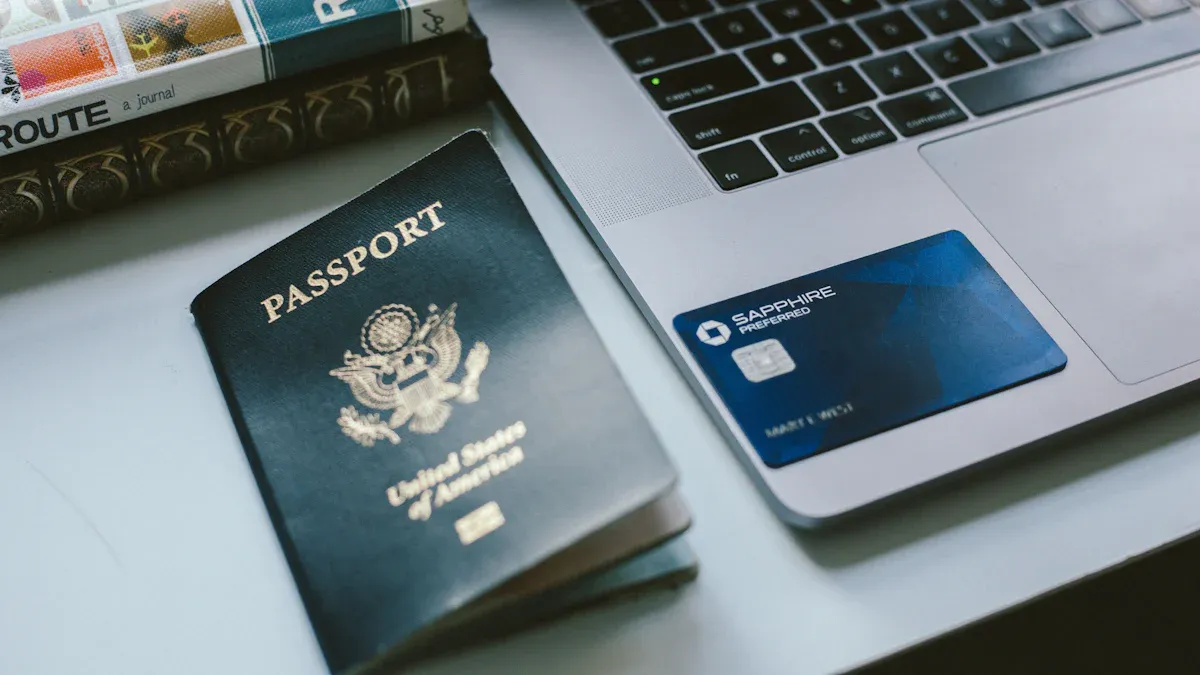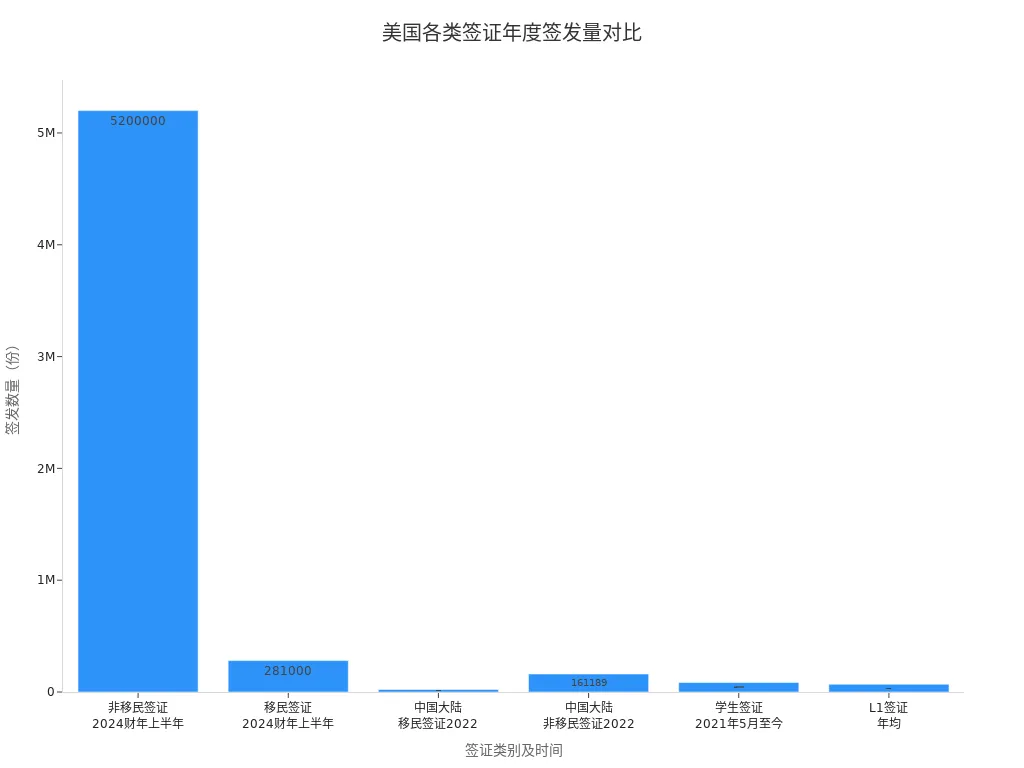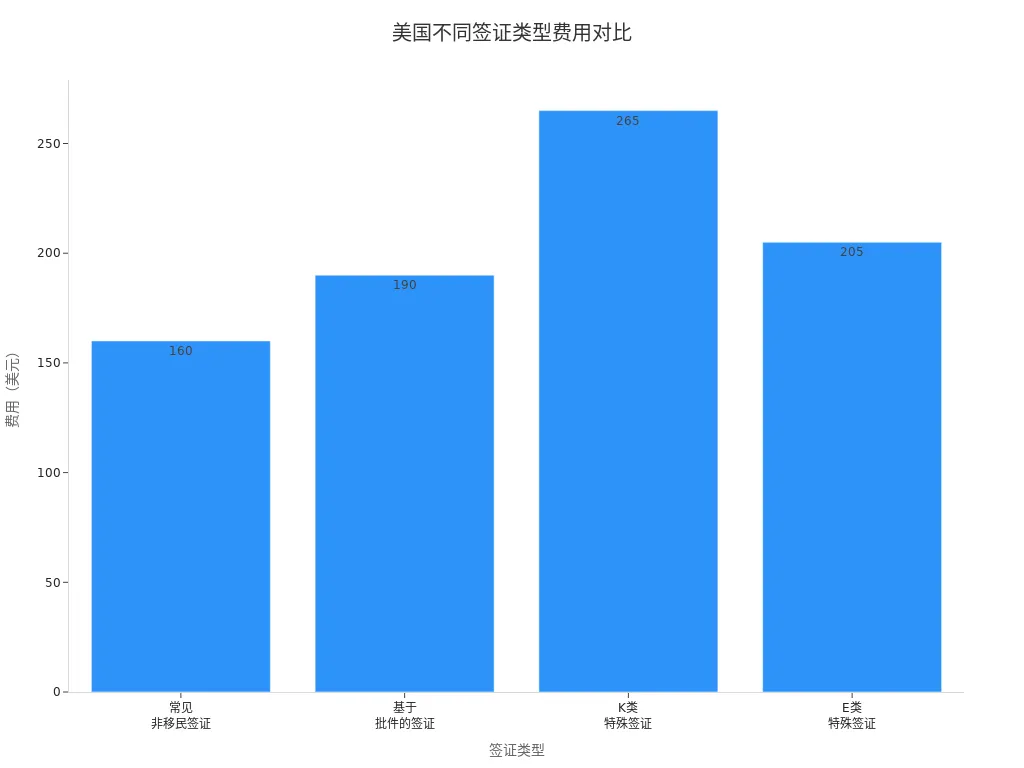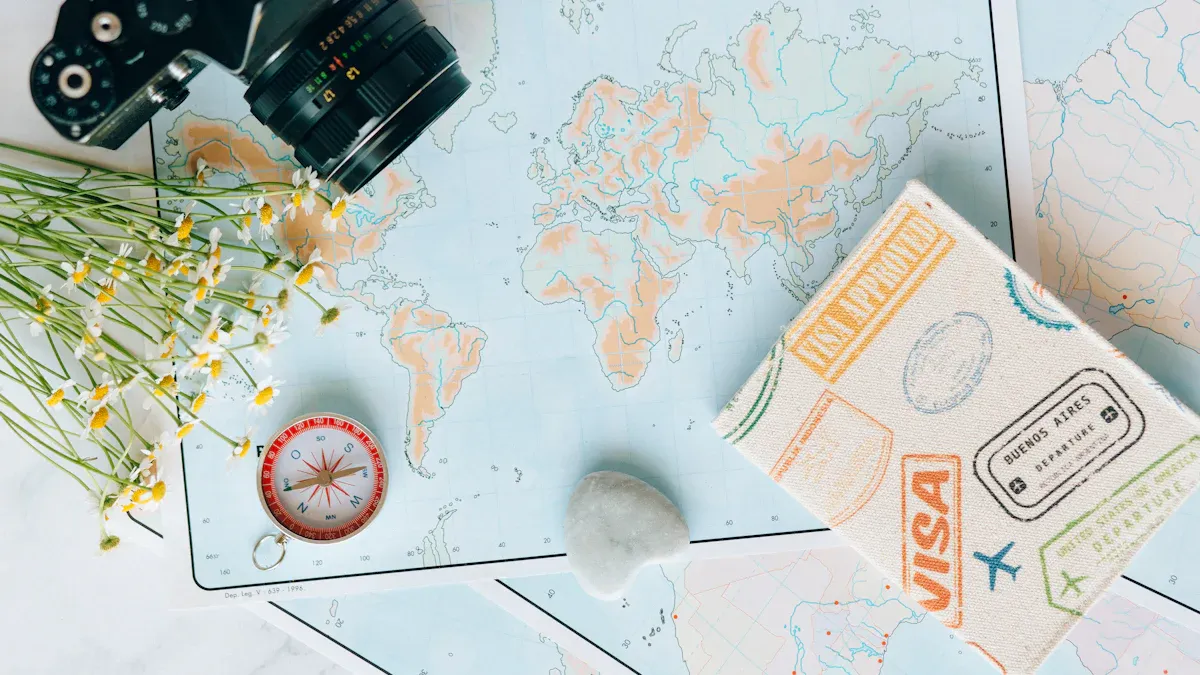- EasyCard
- Trade
- Help
- Announcement
- Academy
- SWIFT Code
- Iban Number
- Referral
- Customer Service
- Blog
- Creator
Complete Guide to Applying for a U.S. Visa: Process, Required Documents, and Tips

Image Source: unsplash
To successfully obtain a U.S. visa, you must understand each step of the process in detail. First, select the appropriate visa type, complete the DS-160 form, pay the visa fee, schedule an interview, prepare documents, and attend the interview. The U.S. issues millions of visas annually, with application numbers increasing yearly.
| Visa Category | Time Period | Issued Visas | Notes |
|---|---|---|---|
| Nonimmigrant Visas | FY 2024 (First Half) | ~5.2 million | ~4.1 million B visas |
| Immigrant Visas | FY 2024 (First Half) | Over 281,000 | Record high |
| China Nonimmigrant | FY 2022 | 161,189 | Mainland China applicants |

Note that the average U.S. visa approval rate in Shanghai is about 40%, while U.S. student visa approval rates are around 80%. This guide to applying for a U.S. visa will help you navigate the process and improve your efficiency.
Key Points
- Applying for a U.S. visa involves selecting a visa type, completing the DS-160 form, paying the fee, scheduling an interview, and attending the interview.
- Ensure all information in the DS-160 form is accurate and truthful, as it cannot be modified after submission; photos must meet embassy standards.
- Keep the receipt number after paying the visa fee, as it’s required for scheduling the interview, along with a printed confirmation page.
- Bring all required documents to the interview, remain confident and polite, and clearly state your purpose for visiting the U.S., avoiding false information.
- Plan ahead, prepare materials thoroughly, and review official information to address issues, increasing your chances of visa approval.
Visa Types
Nonimmigrant Visas
If you plan a short-term visit to the U.S., you’ll typically need a nonimmigrant visa. Common nonimmigrant visa types include:
- Business/Tourism Visas (B1 and B2)
- Work Visas (H, L, O, P, Q)
- Student Visas (F and M)
- Exchange Visitor Visas (J)
Each visa type corresponds to a specific purpose. For example, choose a B visa for tourism or business visits. For studying in the U.S., an F or M visa is appropriate. J visas suit cultural exchanges or visiting scholars.
Immigrant Visas
For long-term residence or work in the U.S., apply for an immigrant visa. U.S. immigrant visas are divided into two main categories:
- Employment-Based Immigration
- EB-1: Outstanding talent, professors, multinational executives
- EB-2: Advanced degree professionals or those with exceptional ability
- EB-3: Skilled workers, professionals
- EB-4: Special occupations, e.g., religious workers
- EB-5: Investment immigration, requiring investment and job creation
- Family-Based Immigration
- Immediate relatives of U.S. citizens (spouse, children under 21, parents)
- Family preference categories (siblings, married children)
Different immigrant visa categories have specific requirements for education, work experience, or investment amounts.
Common Visa Type Comparison
When choosing a visa type, understand the process and document requirements. The table below compares common visa types:
| Visa Type | Eligible Applicants | Key Documents | Application Process |
|---|---|---|---|
| F-1 | Students | I-20 form, transcripts | DS-160, payment, interview |
| M-1 | Vocational students | I-20 form, training proof | DS-160, payment, interview |
| J-1 | Exchange visitors | DS-2019 form, invitation letter | DS-160, payment, interview |
When preparing documents, verify requirements based on your visa type to avoid missing critical files. While interview processes are similar, document details vary.
U.S. Visa Application Guide
Process Overview
To apply for a U.S. visa, follow a standardized process with careful attention to each step. The application typically involves five key steps, requiring thorough preparation to ensure complete documents and accurate information:
- Select Visa Type and Prepare Documents
Choose the appropriate visa type based on your purpose (e.g., tourism, business, study, exchange). Prepare documents including a valid passport, compliant photos, travel itinerary, visa fee (in USD, reference exchange rate 1 USD ≈ 7.2 CNY), and supporting documents.
Tip: Photos must meet U.S. embassy standards; consider professional photography services.
- Complete the DS-160 Form Online
Register an account on the U.S. visa website and fill out the DS-160 nonimmigrant visa application form. Ensure all information is accurate and complete. Print the confirmation page, which is essential for later steps.
Note: The DS-160 form cannot be modified after submission, so review all details before submitting.
- Pay the Visa Fee
Pay the visa fee through designated methods, such as online payment or at a Hong Kong bank counter. Fees are in USD and vary by visa type.
Suggestion: Retain the payment receipt, as it’s required for scheduling the interview.
- Schedule an Interview
Log into the U.S. embassy appointment system, select a suitable interview time and location, and choose a passport/visa pickup method (e.g., in-person or courier).
Reminder: Popular cities like Shanghai and Beijing have limited slots; plan ahead and be flexible with dates.
- Attend the Interview and Submit Documents
Arrive at the embassy/consulate on time with all documents. The visa officer will evaluate your application based on your documents and interview responses.
Interview day process includes security checks, document submission, fingerprinting, and the interview, taking about 40 minutes, with the interview lasting 1–3 minutes.
This U.S. visa application guide emphasizes that no step should be overlooked. Prepare thoroughly to avoid delays due to incomplete documents or errors.
Key Timeline
Pay attention to the timing of each step, as wait times vary by visa type and location. The table below summarizes average wait times to help you plan:
| Application Step | Average Wait Time/Duration | Notes |
|---|---|---|
| DS-160 Form Completion | 30–60 minutes | Information must be accurate; no edits after submission |
| Visa Fee Payment | Instant or 1 business day | Fastest via Hong Kong bank counter |
| Scheduling Interview | 1–4 weeks | May extend during holidays or peak periods |
| Interview Day Process | ~40 minutes to 1–2 hours | Includes security, document submission, fingerprinting, interview |
| Visa Pickup Post-Interview | 8–15 business days | Administrative processing may extend to 1–3 months |
After passing the interview, you can typically collect your passport and visa within 8–15 business days. Administrative processing may extend this to 1–3 months. Banks hold passports for 15 days; collect promptly to avoid return to the embassy.
This guide recommends planning each step carefully and aligning with your travel schedule. For immigrant visas, some categories like family-based (non-immediate relatives) may have wait times of 7–10 years.
Tip: Check appointment availability and processing status on the U.S. embassy website to adjust your plans flexibly.
By following this guide and preparing each step meticulously, you can significantly improve your chances of visa approval.
DS-160 Form
Key Points for Completion
When filling out the DS-160 form, ensure all information is truthful and accurate. Below are common areas prone to errors:
- Verify your expected U.S. arrival date to avoid outdated information.
- Ensure the DS-160 confirmation number matches the appointment confirmation to prevent errors.
- Cross-check I-20 form details (name, birthdate, nationality, program details) for consistency.
- Confirm SEVIS fee payment; unpaid fees must be settled promptly.
- Use the exact name as on your passport; for Chinese names, include a space between characters.
- Complete the DS-160 form in English, except for the name field.
- Review all information before submission, as changes are not allowed afterward.
Tip: Save frequently during completion to avoid data loss. Record the application number and security question for later access.
Photo Requirements
Uploaded or physical photos must meet U.S. embassy standards. The table below outlines requirements:
| Item | Requirements |
|---|---|
| Size | Square, minimum 600x600 pixels, maximum 1200x1200 pixels; physical photos 2x2 inches (~5x5 cm) |
| Head Proportion | Head occupies 50%–70% of photo height; eye level at 55%–70% |
| Photo Age | Taken within the last 6 months |
| Background | Plain white or off-white |
| Glasses | Prohibited since November 1, 2016 |
| Expression/Posture | Eyes open, neutral expression, no smiling, both ears visible |
| Attire | Neat, avoid flashy or offensive patterns, avoid light colors |
| Interview Requirement | Bring a compliant physical photo; use professional services |
Suggestion: If the system rejects your electronic photo, bring a physical photo to the interview.
Common Issues
Common DS-160 form issues include:
- The form must be in English (except for the name); non-compliance may lead to rejection.
- If you have a previous name, select “Yes” and list it, with spaces between Chinese characters.
- For rare Chinese characters without a telecode, use “0000” or select “technology not available.”
- F1 visa part-time work is not considered formal employment; select “No” for work history.
- If photo upload fails, bring a physical photo to the interview.
- If errors are found after printing the confirmation page, revise the form and reprint; the latest version applies.
- Update the DS-160 form if changing interview locations.
- Print the confirmation page with a barcode; otherwise, it’s invalid.
Reminder: Double-check all information before submission to avoid delays due to errors.
Visa Fees
Payment Methods
You must pay the visa fee before scheduling an interview. Register on the U.S. visa application website, ensuring accurate information. Select “Schedule Appointment,” choose the visa type and embassy location, then proceed to payment. Payment options include:
- Paying directly at a Hong Kong bank counter.
- Using an ATM for payment.
- Online banking transfer.
After payment, retain the receipt number, which is required for scheduling the interview. Only after paying and recording the receipt number can you book an appointment.
Reminder: Visa fees are non-refundable and non-transferable. Verify all information before payment to avoid losses.
Fee Structure
Visa fees vary by type and were adjusted as of May 30, 2023. Refer to the table below for updated fee standards (in USD, reference exchange rate 1 USD ≈ 7.2 CNY):
| Visa Type | Old Fee (USD) | New Fee (USD) |
|---|---|---|
| Tourism & Other Non-Petition Visas | 160 | 185 |
| Petition-Based Visas (H, L, O, P, Q, R) | 190 | 205 |
| E Visas (Treaty Traders, Investors) | 205 | 315 |
For B1/B2 tourism or business visas, the fee is $185. Petition-based visas (H, L, O, etc.) cost $205, and E visas cost $315. All fees are non-refundable.
The chart below shows a comparison of U.S. visa fees by type:

Fees may change due to policy or economic factors. Check the U.S. Embassy in China’s latest announcements before applying to ensure correct payment.
Scheduling the Interview
Appointment Process
Follow the standard process to schedule a U.S. visa interview, consisting of seven key steps:
- Register and log into the U.S. visa appointment website.
- Select the visa type (immigrant or nonimmigrant), embassy location, and specific visa category.
- Enter applicant information, ideally after completing the DS-160 form for automatic syncing to reduce errors.
- Choose a passport delivery location (e.g., CITIC Bank branch or a specified address).
- Pay the visa fee via online payment or at a Hong Kong bank counter. For 2024, B1/B2 visa fees are $185 (USD, reference exchange rate 1 USD ≈ 7.2 CNY).
- Enter the receipt number to proceed with scheduling, selecting a suitable interview date and time.
- Print the appointment confirmation page and bring it to the interview.
Reminder: If eligible for an interview waiver (e.g., under 14, over 80, or holding a valid visa expired within 12 months), you can apply for drop-off service. You must be in China, with the same visa type and prior fingerprint collection.
Key Considerations
When scheduling the interview, note:
- If ideal time slots are unavailable, consider expedited appointment services through third-party agents, which may incur extra fees.
- Ensure all information matches the DS-160 form to avoid invalid appointments.
- Choose CITIC Bank branches for convenient passport pickup.
- The receipt number is critical; only the correct number allows scheduling.
- Print the confirmation page, as it’s required on interview day.
Plan ahead to avoid delays during peak periods. If you encounter system issues, try again or use a different browser.
Document Preparation

Image Source: pexels
Core Documents
Ensure core documents are complete. The table below summarizes common requirements:
| Document Category | Specific Documents | Notes |
|---|---|---|
| Basic Information | Personal information form (original) | Must be complete and accurate |
| Passport (original) | Valid for at least 6 months beyond stay; include old passports | |
| Photo (original) | Taken within 6 months, 2x2 inches, white background, head occupies 50% | |
| ID card (original & copy) | Copy both sides | |
| Household register (copy, for under 14) | Full copy of household register with parents | |
| Birth certificate (copy) | If unavailable, provide notarized affidavit (English & Chinese) | |
| Travel & Invitation | Itinerary or travel plan | Detailed trip schedule |
| Financial Proof | Bank deposit certificate (original) | Bank-stamped, suggested balance $50,000 (USD, 1 USD ≈ 7.2 CNY) |
| Vehicle/property deeds (copy) | Copies of property and vehicle ownership under your name |
Tip: Bring both originals and copies of all documents to avoid interview delays.
Supplementary Documents
Enhance credibility with supplementary documents:
- Identity documents (ID card, household register, birth certificate) to verify identity and family ties.
- Financial proof like property deeds, vehicle registration, investment records, or employment/income proof to show financial stability.
- Professional background documents (business license, employment letter, payslips) to demonstrate career stability.
- U.S. travel plans, including accommodation bookings, travel routes, attraction plans, or invitation letters, to prove a reliable itinerary.
- U.S. connections, such as admission letters, internship contracts, or invitation letters, to clarify your purpose.
These documents help visa officers understand your background and travel plans, boosting approval chances.
Documents for Specific Cases
For special statuses, prepare additional documents:
- Official passport/permit holders need invitation letters, DS-160 confirmation, a passport valid for 6+ months, expense proof, 50mmx50mm white-background photos, English resume, and itinerary.
- Applicants with specialized education backgrounds face at least 3 weeks of background checks; plan accordingly.
- For 10-year B1/B2 visas, update EVUS information 72 hours before departure and carry a printed copy for border checks.
- Certain visa types (L, I, P-3, H-2B) are ineligible for interview waivers; drop-off materials must be submitted via provincial foreign affairs offices.
- Bring interview confirmation, work ID, ID card, household register, and pay visa fees via Hong Kong banks, retaining the receipt.
Follow the U.S. embassy and foreign affairs ministry’s latest notices to adjust your document preparation and ensure approval.
Interview Process

Image Source: pexels
Process Steps
Follow these standard steps for the U.S. visa interview:
- Prepare all documents, including a valid passport, compliant photos, DS-160 confirmation, appointment confirmation, and fee receipt.
- Complete and submit the DS-160 form online, printing the confirmation page.
- Pay the visa fee via Hong Kong banks or online, retaining the receipt. For 2024, B1/B2 visa fees are $185 (USD, 1 USD ≈ 7.2 CNY).
- Schedule the interview via the appointment system, selecting a time and location, and print the confirmation page.
- Arrive at the embassy/consulate on time with all documents, maintaining a positive attitude for the interview.
This guide recommends planning each step to avoid missing documents or deadlines.
Common Issues
On interview day, you may encounter:
- Arrive 30 minutes early; security checks prohibit electronic devices like phones.
- Bring core documents: passport (valid 6+ months), DS-160 confirmation, appointment confirmation, photos. Supporting documents include admission letters, transcripts, employer letters, payslips, and financial proof like bank statements.
- Common questions cover self-introduction, purpose of visit, and return plans. Provide concise answers and supporting documents.
- Emphasize ties to China (family, job, studies) with documents like property deeds or employment contracts.
- Dress neatly (men: shirt and slacks; women: simple suit or dress) and maintain a calm, confident demeanor.
If nervous, practice deep breathing or mock interviews. Avoid false documents or information, as this leads to rejection.
Interview Tips
Boost your approval chances with these tips:
- Prepare all documents, including passport, resume, transcripts, and financial proof, presenting them proactively when relevant.
- Stay relaxed and confident, avoiding nervous gestures. Smile and make eye contact with the visa officer.
- Answer in clear English, listening carefully before responding to avoid confusion.
- Be honest, avoiding lies or evading sensitive topics; officers trust truthful applicants.
- Highlight ties to China and a clear travel plan to alleviate concerns about overstaying.
This guide emphasizes thorough preparation and confident communication as keys to success.
Visa Results
Checking Status
After the interview, check your visa status via official channels using your application number, birthdate, and full name. Common methods include:
- The U.S. Department of State’s CEAC website: Enter your application number and surname to check status, appointment times, or upload files.
- USCIS website: Use “Check My Case Status” with your case number and birthdate for immigrant visa progress.
- State Department’s visa status page: For K or EB-5 visas, enter the DS-160 barcode or appointment confirmation number for real-time updates.
- Email, phone, or SMS notifications provide supplementary updates but are less reliable.
Use official websites for accurate information. If the system delays, try again the next day.
Passport Pickup
Once approved, collect your passport and visa page. Choose CITIC Bank branches in China or paid courier services (mainland China only). The process includes:
- After receiving the embassy’s “documents ready” email, visit the appointment website, enter your UID, select a date/time, and save the QR code.
- Arrive at the designated branch on time; arriving over 15 minutes late voids the appointment. Passports are held for 15 days; uncollected passports return to the embassy, affecting future applications.
- Bring a government-issued ID and QR code; carry a copy of the appointment letter.
- For third-party pickup, provide a signed authorization letter and both parties’ IDs. Educational institutions or travel agencies need formal authorization and group member signatures.
- For courier services, pay EMS fees on-site (in USD, 1 USD ≈ 7.2 CNY) to ensure secure delivery.
Collect your passport personally or use courier services to avoid loss. Contact the embassy or CITIC Bank for issues.
Key Considerations and Pitfalls
Improving Approval Chances
To increase your U.S. visa approval rate, prepare meticulously at every step:
- Prepare all required documents, including passport, photos, DS-160 confirmation, fee receipt, and appointment confirmation. Schedule during non-peak periods for better availability.
- Ensure accurate personal information in the application, answering all questions truthfully and saving data to avoid errors.
- Practice mock interviews, preparing for self-introduction and common questions. Be confident, polite, and provide supporting documents like invitation letters or family ties.
- For urgent cases, request expedited appointments with proof. If rejected, analyze reasons, improve documents, and reapply.
- Provide employment letters, payslips, or return tickets to prove ties to China. Purchase international travel insurance, especially for applicants 75+, to show health coverage.
Arrive early on interview day, dress appropriately, and maintain a polite, confident demeanor to make a positive impression.
Common Pitfalls
Avoid these common mistakes:
- Failing to submit the DS-160 form on time, invalidating your interview eligibility.
- Mixing up numbers and letters in the DS-160 number, causing information errors.
- Providing inaccurate personal details, delaying the interview process.
- Not updating the appointment system after revising the DS-160, leading to mismatched numbers.
- Failing to input corresponding DS-160 numbers for group appointments, causing mismatches.
- Bringing a DS-160 confirmation page with a number different from the appointment, preventing interview participation.
- Incomplete documents, e.g., missing passport, invitation letter, or financial proof.
- Incomplete or incorrect application forms, impacting review.
- Inability to prove strong ties to China, lacking socioeconomic connections.
- Nervousness during the interview, unclear or inconsistent answers.
- Providing false documents, leading to rejection due to credibility issues.
- Holding a blank passport with no travel history, triggering stricter scrutiny.
- Being from a sensitive region, requiring additional security proof.
Avoid these errors by double-checking documents and information, following this guide to boost approval chances.
When applying for a U.S. visa, prepare documents methodically, ensuring DS-160 and appointment details align. The interview is critical, with officers focusing on your travel purpose and document authenticity. Schedule early, attend on time, and remain confident and polite. Address issues proactively and wait patiently for processing. By tailoring your preparation to your situation and following this guide, you can significantly increase your approval chances.
FAQ
Can you use an old passport to apply for a U.S. visa?
You must use a passport valid for at least six months beyond your stay. Bring old passports to provide travel history for the visa officer’s review.
What items can you bring into the embassy on interview day?
Only bring essential documents. Electronic devices (phones, laptops, USB drives) are prohibited. Carry your passport, DS-160 confirmation, photos, and appointment confirmation.
Are visa fees refundable?
Visa fees are non-refundable. For 2024, B1/B2 visa fees are $185 (USD, 1 USD ≈ 7.2 CNY). Verify all information before payment.
How long after the interview can you collect your passport and visa?
Typically, you can collect your passport and visa within 8–15 business days. Administrative processing may extend this to 1–3 months.
Can you pay the visa fee with a non-Chinese bank?
You must pay via designated Hong Kong bank counters, ATMs, or online banking. Other bank channels are not supported. Retain the receipt number for scheduling.
Successfully applying for a U.S. visa is the crucial first step to your journey. From filling out the DS-160 form and paying the visa fee to preparing for your interview, every step requires careful attention. However, throughout this process, you may need to handle cross-border remittances, pay visa fees, or even transfer funds to an overseas account. These international financial operations often come with high fees and complex procedures.
BiyaPay offers a seamless solution to these cross-border financial challenges. Our platform supports flexible conversions between various fiat and digital currencies and provides real-time exchange rate inquiries, ensuring you get the best rates when paying visa fees and managing your international funds. With a simple registration, you can benefit from our ultra-low transaction fees, starting from just 0.5%, and transfer funds quickly to most countries and regions worldwide, with transfers often completed on the same day. Choose BiyaPay to make every step of your visa application more manageable, so you can focus on your preparation rather than complex financial processes.
*This article is provided for general information purposes and does not constitute legal, tax or other professional advice from BiyaPay or its subsidiaries and its affiliates, and it is not intended as a substitute for obtaining advice from a financial advisor or any other professional.
We make no representations, warranties or warranties, express or implied, as to the accuracy, completeness or timeliness of the contents of this publication.




Contact Us
Company and Team
BiyaPay Products
Customer Services
is a broker-dealer registered with the U.S. Securities and Exchange Commission (SEC) (No.: 802-127417), member of the Financial Industry Regulatory Authority (FINRA) (CRD: 325027), member of the Securities Investor Protection Corporation (SIPC), and regulated by FINRA and SEC.
registered with the US Financial Crimes Enforcement Network (FinCEN), as a Money Services Business (MSB), registration number: 31000218637349, and regulated by FinCEN.
registered as Financial Service Provider (FSP number: FSP1007221) in New Zealand, and is a member of the Financial Dispute Resolution Scheme, a New Zealand independent dispute resolution service provider.



















